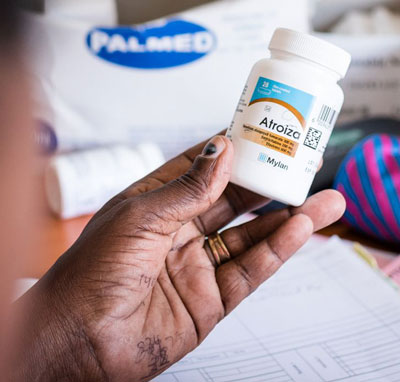HIV infects cells of the immune system. Once inside, it hijacks the cellular molecular machineries to make more copies of itself, which are then transmitted to new host cells. HIV eventually kills most cells it infects, either in the steps leading to the infection of the cell, or after the cell is already producing the virus. HIV can spread between cells in two ways, known as cell-free or cell-to-cell. In the first, individual viruses are released from infected cells and move randomly through the body in the hope of finding new cells to infect. In the second, infected cells interact directly with uninfected cells. The second method is often much more successful in infecting new cells since they are exposed to multiple virus particles.

Figure: Efavirenz is a key drug in first line antiretroviral therapy in Africa and elsewhere.
HIV infections can be controlled by using combinations of antiretroviral drugs, such as Efavirenz, to prevent the virus from making more of itself. With a high enough dose, the drugs can in theory completely stop HIV infections, unless the virus becomes resistant to treatment. However, some patients continue to use these drugs even after the virus they are infected with develops resistance. It is not clear what effect taking ineffective, or partially effective, drugs has on how HIV progresses. HFSP funding enabled Jackson et al. to investigate this question.
Using Efavirenz, Jackson et al. partially limited the spread of HIV between human cells grown in the laboratory. The experiments mirrored the situation where a partially resistant HIV strain spreads through the body. The results show that the success of cell-free infection is reduced as drug dose increases. Yet, paradoxically, in cell-to-cell infection, the presence of the drug caused more cells to become infected. This can be explained by the fact that, in cell-to-cell spread, each cell is exposed to multiple copies of the virus. The drug dose reduced the number of viral copies per cell without stopping the virus from infecting completely. The reduced number of viral copies per cell make it more likely that infected cells survive the infection long enough to produce virus particles themselves.
Viruses that can kill cells, such as HIV, must balance the need to make more of themselves against the speed that they kill their host cell to maximize the number of infected cells. If transmission between cells is too effective and too many virus particles are delivered to the new cell, the virus may not manage to infect new hosts before killing the old ones. These findings highlight this delicate balance. They also indicate a potential issue in using drugs to treat partially resistant virus strains. Without care, these treatments could increase the number of infected cells in the body, potentially worsening the effects of living with HIV.
Reference
Incomplete inhibition of HIV infection results in more HIV infected lymph node cells by reducing cell death. Laurelle Jackson, Jessica Hunter, Sandile Cele, Isabella Markham Ferreira, Andrew C Young, Farina Karim, Rajhmun Madansein, Kaylesh J Dullabh, Chih-Yuan Chen Noel J Buckels, Yashica Ganga, Khadija Khan, Mikael Boulle, Gila Lustig, Richard A Neher, Alex Sigal. Journal citation: eLife 2018;7:e30134


































